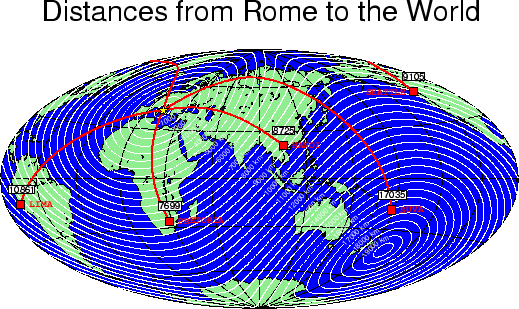 |
While motorists recenty have started to question the old saying ``all roads lead to Rome'', aircraft pilots have known from the start that only one great-circle path connects the points of departure and arrival7.5. This provides the inspiration for our next example which uses grdmath to calculate distances from Rome to anywhere on Earth and grdcontour to contour these distances. We pick five cities that we connect to Rome with great circle arcs, and label these cities with their names and distances (in km) from Rome, all laid down on top of a beautiful world map. Note that we specify that contour labels only be placed along the straight map-line connecting Rome to its antipode, and request curved labels that follows the shape of the contours.
#!/bin/csh
#
# GMT Example 23 $Id: job23.csh,v 1.10 2004/07/13 18:47:09 pwessel Exp $
#
# Purpose: Plot distances from Rome and draw shortest paths
# GMT progs: gmtset, grdmath, grdcontour, psxy, pstext, grdtrack
# Unix progs: echo, cat, awk
# Position and name of central point:
set lon = 12.50
set lat = 41.99
set name = "Rome"
# Calculate distances (km) to all points on a global 1x1 grid
grdmath -Rg -I1 $lon $lat SDIST 111.13 MUL = dist.grd
# Location info for 5 other cities + label justification
cat << EOF >! cities.d
105.87 21.02 HANOI LM
282.95 -12.1 LIMA LM
178.42 -18.13 SUVA LM
237.67 47.58 SEATTLE RM
28.20 -25.75 PRETORIA LM
EOF
pscoast -Rg -JH90/9i -Glightgreen -Sblue -U"Example 23 in Cookbook" -A1000 \
-B0g30:."Distances from $name to the World": -K -Dc -Wthinnest >! example_23.ps
grdcontour dist.grd -A1000+v+ukm+kwhite -Glz-/z+ -S8 -C500 -O -K -J -Wathin,white \
-Wcthinnest,white,- >> example_23.ps
# Find the number of cities:
set n = `cat cities.d | wc -l`
# For each of these cities, plot great circle arc with psxy
set i = 1
while ($i <= $n)
set record = `awk '{ if (NR == '$i') print $0}' cities.d`
(echo $lon $lat; echo $record[1] $record[2]) | psxy -R -J -O -K -W2p/red >> example_23.ps
@ i++
end
# Plot red squares at cities and plot names:
psxy -R -J -O -K -Ss0.2 -Gred -W0.25p cities.d >> example_23.ps
awk '{print $1, $2, 12, 1, 9, $4, $3}' cities.d \
| pstext -R -J -O -K -Dj0.15/0 -Gred -N >> example_23.ps
# Place a yellow star at Rome
echo "$lon $lat" | psxy -R -J -O -K -Sa0.2i -Gyellow -Wthin >> example_23.ps
# Sample the distance grid at the cities and use the distance in km for labels
grdtrack -Gdist.grd cities.d \
| awk '{printf "%s %s 12 0 1 CB %d\n", $1, $2, int($NF+0.5)}' \
| pstext -R -J -O -D0/0.2i -N -Wwhiteo -C0.02i/0.02i >> example_23.ps
# Clean up after ourselves:
\rm -f cities.d dist.grd .gmt*
The script produces the plot in Figure 7.24; note how interesting the path to Seattle appears in this particular projection (Hammer). We also note that Rome's antipode lies somewhere near the Chatham plateau (antipodes will be revisited in Example 25).